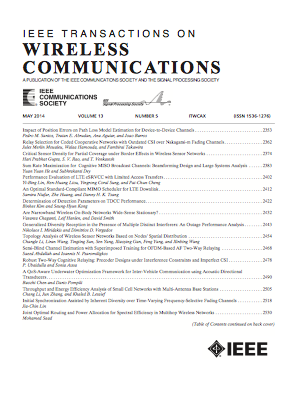Robust Precoder Design for Massive MIMO High-Speed Railway Communications With Matrix Manifold Optimization
IF 10.7
1区 计算机科学
Q1 ENGINEERING, ELECTRICAL & ELECTRONIC
引用次数: 0
Abstract
In high-speed railway (HSR) communications, the channel suffers from severe Doppler and channel aging effects caused by the high mobility, making the channel outdated quickly. To address this issue, we investigate the robust precoder design against channel aging and prediction inaccuracy in massive multiple-input multiple-output (MIMO) systems with matrix manifold optimization. First of all, we introduce the concept of the quadruple beams (QBs), and establish a QB based channel model with sampled quadruple steering vectors. Then, the upcoming space domain channel of interest can achieve a higher accuracy by channel prediction with the estimated QB domain channel. To further improve the performance while save the pilot overhead, we predict the forthcoming QB domain channel and integrate the prediction inaccuracy within the a posterior QB domain statistical channel model. Then, we consider the robust precoder design aiming to maximize the upper bound of the ergodic weighted sum-rate (WSR) on the Riemannian submanifold formed by the precoders satisfying the total power constraint (TPC). Riemannian ingredients are derived for matrix manifold optimization, with which the Riemannian conjugate gradient (RCG) method is proposed to solve the unconstrained problem on the manifold. The RCG method mainly involves the matrix multiplication and avoids the need of matrix inversion of the transmit antenna dimension. The simulation results demonstrate the effectiveness of the proposed channel model and the superiority of the RCG method for robust precoder design against channel aging and prediction inaccuracy.基于矩阵流形优化的高速铁路海量MIMO通信鲁棒预编码器设计
在高速铁路通信中,由于高迁移率,信道受到严重的多普勒效应和信道老化效应的影响,使信道迅速过时。为了解决这个问题,我们研究了基于矩阵流形优化的大规模多输入多输出(MIMO)系统中抗信道老化和预测不准确的鲁棒预编码器设计。首先,我们引入了四重波束的概念,建立了基于四重波束的采样四重转向矢量信道模型。然后,利用估计的QB域信道对即将到来的感兴趣的空间域信道进行信道预测,从而达到更高的精度。为了进一步提高性能,同时节省导频开销,我们对即将到来的QB域信道进行了预测,并将预测误差集成到一个后检的QB域统计信道模型中。然后,我们考虑了鲁棒预编码器的设计,其目的是最大化由满足总功率约束(TPC)的预编码器形成的黎曼子流形上的遍历加权和率(WSR)的上界。推导了矩阵流形优化的黎曼分量,并利用黎曼共轭梯度(RCG)方法求解了流形上的无约束问题。RCG方法主要涉及矩阵乘法,避免了对发射天线尺寸进行矩阵反演的需要。仿真结果表明了该信道模型的有效性,以及RCG方法在抗信道老化和预测误差的鲁棒预编码器设计中的优越性。
本文章由计算机程序翻译,如有差异,请以英文原文为准。
求助全文
约1分钟内获得全文
求助全文
来源期刊
CiteScore
18.60
自引率
10.60%
发文量
708
审稿时长
5.6 months
期刊介绍:
The IEEE Transactions on Wireless Communications is a prestigious publication that showcases cutting-edge advancements in wireless communications. It welcomes both theoretical and practical contributions in various areas. The scope of the Transactions encompasses a wide range of topics, including modulation and coding, detection and estimation, propagation and channel characterization, and diversity techniques. The journal also emphasizes the physical and link layer communication aspects of network architectures and protocols.
The journal is open to papers on specific topics or non-traditional topics related to specific application areas. This includes simulation tools and methodologies, orthogonal frequency division multiplexing, MIMO systems, and wireless over optical technologies.
Overall, the IEEE Transactions on Wireless Communications serves as a platform for high-quality manuscripts that push the boundaries of wireless communications and contribute to advancements in the field.

 求助内容:
求助内容: 应助结果提醒方式:
应助结果提醒方式:


